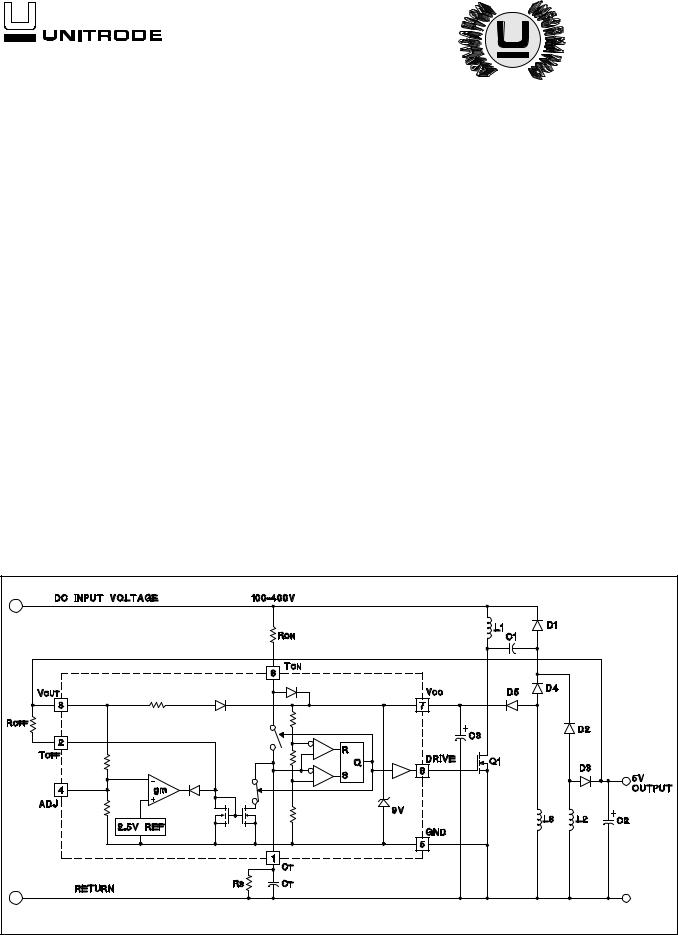Texas Instruments UCC3888N, UCC3888DTR, UCC3888D, UCC2888DTR, UCC2888D Datasheet

UCC1888
UCC2888
UCC3888
Off-line Power Supply Controller
FEATURES
∙Transformerless Off-line Power Supply
∙Wide 100VDC to 400VDC Allowable Input Range
∙Fixed 5VDC or Adjustable Low Voltage Output
∙Output Sinks 200mA, Sources 150mA Into a MOSFET Gate
∙Uses Low Cost SMD Inductors
∙Short Circuit Protected
∙Optional Isolation Capability
DESCRIPTION
The UCC3888 controller is optimized for use as an off-line, low power, low voltage, regulated bias supply. The unique circuit topology utilized in this device can be visualized as two cascaded flyback converters, each operating in the discontinuous mode, both driven from a single external power switch. The significant benefit of this approach is the ability to achieve voltage conversion ratios as high as 400V to 2.7V with no transformer and low internal losses.
The control algorithm utilized by the UCC3888 sets the switch on time inversely proportional to the input line voltage and sets the switch off time inversely proportional to the output voltage. This action is automatically controlled by an internal feedback loop and reference. The cascaded configuration allows a voltage conversion from 400V to 2.7V to be achieved with a switch duty cycle of 7.6%. This topology also offers inherent short circuit protection since as the output voltage falls to zero, the switch off time approaches infinity.
The output voltage is set internally to 5V. It can be programmed for other output voltages with two external resistors. An isolated version can be achieved with this topology as described further in Unitrode Application Note U-149.
OPERATION
With reference to the application diagram below, when input voltage is first applied, the current through RON into TON is directed to VCC where it charges the external capacitor, C3, connected to VCC. As voltage builds on VCC, an internal undervoltage lockout holds the circuit off and the output at DRIVE low until VCC reaches 8.4V. At this time, DRIVE goes high turning on the power switch, Q1, and redirecting the current into TON to the timing capacitor, CT. CT charges to a fixed threshold with a current ICHG=0.8 ∙ (VIN - 4.5V)/RON. Since DRIVE will only be high for as long as CT charges, the power switch on time will be inversely proportional to line voltage. This provides a constant (line voltage) ∙ (switch on time) product.
TYPICAL APPLICATION
Note: This device incorporates patented technology used under license from Lambda Electronics, Inc.
UDG-96013
3/97

OPERATION (cont.)
At the end of the on time, Q1 is turned off and the current through RON is again diverted to VCC. Thus the current through RON, which charges CT during the on time, contributes to supplying power to the chip during the off time.
The power switch off time is controlled by the discharge of CT which, in turn, is programmed by the regulated output voltage. The relationship between CT discharge current, IDCHG, and output voltage is illustrated as follows:
Region 1. When VOUT = 0, the off time is infinite. This feature provides inherent short circuit protection. However, to ensure output voltage startup when the output is not a short, a high value resistor, RS, is placed in parallel with CT to establish a minimum switching frequency.
Region 2. As VOUT rises above approximately 0.7V to its regulated value, IDCHG is defined by ROFF, and is equal to:
UCC1888
UCC2888
UCC3888
IDCHG = (VOUT - 0.7V) / ROFF
As VOUT increases, IDCHG increases reducing off time. The operating frequency increases and VOUT rises quickly to its regulated value.
Region 3. In this region, a transconductance amplifier reduces IDCHG in order to maintain a regulated VOUT.
Region 4. If VOUT should rise above its regulation range, IDCHG falls to zero and the circuit returns to the minimum frequency established by RS and CT.
The range of switching frequencies is established by RON, ROFF, RS, and CT as follows:
Frequency = 1/(TON + TOFF)
TON = RON ∙ CT ∙ 4.6 V/(VIN - 4.5V)
TOFF (max) = 1.4 ∙ RS ∙ CT
Regions 1 and 4
TOFF = ROFF ∙ CT ∙ 3.7V /(VOUT - 0.7V) Region 2, excluding the effects of RS which have a minimal impact on TOFF.
The above equations assume that VCC equals 9V. The voltage at TON increases from approximately 2.5V to 6.5V while CT is charging. To take this into account, VIN is adjusted by 4.5V in the calculation of TON. The voltage at TOFF is approximately 0.7V.
DESIGN EXAMPLE
The UCC3888 regulates a 5 volt, 1 Watt nonisolated DC output from AC inputs between 80 and 265 volts. In this example, the IC is programmed to deliver a maximum on time gate drive pulse width of 2.2 microseconds which occurs at 80 VAC. The corresponding switching frequency is approximately 100kHz at low line, and overall efficiency is approximately 50%. Additional design information is available in Unitrode Application Note U-149.
UDG-96014 |
2 |
